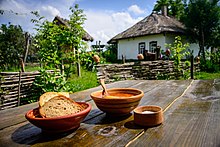
Back Borsjt Afrikaans برش (حساء) Arabic Borş Azerbaijani Борщ Bashkir Boruokīnė BAT-SMG Боршч Byelorussian Боршч BE-X-OLD Борш Bulgarian বোর্শ Bengali/Bangla Boršč BS
 A bowl of borscht garnished with sour cream and dill | |
| Alternative names | Borsch, borshch, borsht, bortsch |
|---|---|
| Type | Soup |
| Place of origin | Ukraine[1][2] |
| Cooking time | 30 minutes to 3 hours |
| Serving temperature | Hot or cold |
| Main ingredients | Beet sour or beetroots |
| Ingredients generally used | Tomatoes, vinegar, cabbage and/or potatoes, meat or salo |
| Variations | Clear red borscht, cold borscht, unsoured borscht |
| Similar dishes | Green borscht, white borscht as well as the ancient hogweed-made borscht |
| Culture of Ukrainian borscht cooking | |
|---|---|
 Borscht served in a ceramic bowl with bread and salt in a village in the Poltava region of Ukraine | |
| Country | Ukraine |
| Reference | 01852 |
| Region | Europe and North America |
| Inscription history | |
| Inscription | 2022 (5th extraordinary session) |
| List | Need of Urgent Safeguarding |
Borscht (English: /ˈbɔːrʃt/ ⓘ) is a sour soup, made with meat stock, vegetables and seasonings, common in Eastern Europe and Northern Asia. In English, the word borscht is most often associated with the soup's variant of Ukrainian origin, made with red beetroots as one of the main ingredients, which give the dish its distinctive red color. The same name, however, is also used for a wide selection of sour-tasting soups without beetroots, such as sorrel-based green borscht, rye-based white borscht, and cabbage borscht.
Borscht derives from an ancient soup originally cooked from pickled stems, leaves and umbels of common hogweed (Heracleum sphondylium), an herbaceous plant growing in damp meadows, which lent the dish its Slavic name. With time, it evolved into a diverse array of tart soups, among which the Ukrainian beet-based red borscht has become the most popular. It is typically made by combining meat or bone stock with sautéed vegetables, which—as well as beetroots—usually include cabbage, carrots, onions, potatoes, and tomatoes. Depending on the recipe, borscht may include meat or fish, or be purely vegetarian; it may be served either hot or cold, and it may range from a hearty one-pot meal to a clear broth or a smooth drink. It is often served with smetana or sour cream, hard-boiled eggs or potatoes, but there exists an ample choice of more involved garnishes and side dishes, such as uszka or pampushky, that can be served with the soup.
Its popularity has spread throughout Eastern Europe and—by way of migration away from the Russian Empire—to other continents. In North America, borscht is often linked with either Jews or Mennonites, the groups who first brought it there from Europe. Several ethnic groups claim borscht, in its various local implementations, as their own national dish consumed as part of ritual meals within Eastern Orthodox,[citation needed] Greek Catholic, Roman Catholic, and Jewish religious traditions.
- ^ Schultze (2000), pp. 65–66.
- ^ Marks (2010), pp. 196–200, "Borscht".